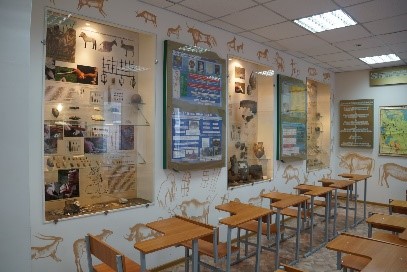The Archaeological Laboratory at the Ahmed Baytursynuly Kostanay Regional University was founded by V.N. Logvin in 1980. Since 1998, the head of the archaeological laboratory has been A.V. Logvin.

The main areas of research include:
- conducting salvage work on deteriorating archaeological sites in the region;
- studying the Stone Age of Turgai;
- researching Bronze Age sites in Turgai;
- studying sites from the early Iron Age and the Middle Ages;
- researching the paleoeconomy of ancient societies: stone tools, bone carving, pottery, metallurgy, agriculture, etc.;
- studying burial rites and the spiritual culture of ancient societies: studying anthropological types, ancient genomes, and the paleodiet of Turgai tribes.
All research is conducted with the involvement of natural sciences (genetic analysis, radiocarbon and dendrochronological analysis, binocular and petrographic analysis of ceramics, georadar study of sites, isotopic analysis of human and animal bones, paleozoological analysis of animal bones, etc.).
Since the independence of Kazakhstan, the laboratory staff has discovered more than 500 archaeological sites in the Kostanay region (these include Stone Age settlements, Bronze Age settlements and burial mounds, early Iron Age and medieval burial mounds). Stationary archaeological excavations have been conducted at more than 20 sites. Among the most famous are the Bestamak burial mound (studied with the support of the republican program "Cultural Heritage" initiated by the First President) and the Halvai 3 and Karatomar burial mounds.
Based on the results of field research, laboratory staff publish articles in scientific journals of Kazakhstan, near and far abroad. In addition, laboratory staff actively participate in international archaeological conferences in Kazakhstan and nearby countries. Since 2011, the archaeological laboratory has been conducting its research within the framework of grant funding from the Ministry of Education and Science of the Republic of Kazakhstan. The results of the grant from the Ministry of Education and Science of the Republic of Kazakhstan, received in 2011-2013, on the topic: "Study of the archaeological heritage of Turgai in the context of interaction of the oldest peoples of Eurasia: transcultural connections, ethnosocial processes, paleoeconomy" resulted in the publication of a scientific monograph in 2014 by I.V. Shevnina "Pottery of the Neolithic tribes of Turgai" (Astana, 2014) and the defense of her dissertation related to this issue. The study of the Halvai burial mound in 2015-2017 was carried out within the framework of grant funding from the Ministry of Education and Science of the Republic of Kazakhstan "Migration, ethnosocial processes, paleoeconomy of Turgai in the era of paleometal and the Hunnic-Sarmatian time in the light of new archaeological research." The result of the grant was the publication of two monographs:
- Shevnina I.V., Logvin A.V. The Bronze Age burial mound Halvai 3 in Northern Kazakhstan, Astana, 2015);
- Logvin A.V., Shevnina I.V., Seitov A.M., Neteta A.V. Ritual-sacral geometric complexes "geoglyphs" of Turgai, Kostanay, 2018) and the defense of the dissertation by A.V. Logvin.
Currently, laboratory staff are conducting research under a grant from the Ministry of Education and Science of the Republic of Kazakhstan on the topic: "New research on the Neolithic of Turgai: sites and artifacts, chronology and transcultural connections, environment and paleoeconomy," received in 2021.
The study of the archaeological heritage of Turgai is conducted in close cooperation with many scientists from different countries. Since 2015, our laboratory has been a participant in a large international team studying ancient DNA (Center for GeoGenetics, University of Copenhagen). The study of the ancient genomes of people from Bestamak, Halvai, and Karatomar was conducted by a team of geneticists from Denmark (Center for GeoGenetics, University of Copenhagen) under the leadership of the renowned geneticist Eske Willerslev; the study of isotopes as part of the diet of Bronze Age humans was conducted by our colleague from the USA (Alisha Ventresca), paleozoological research was conducted by osteologists L.L. Gayduchenko (Chelyabinsk) and P.A. Kosintsev (Yekaterinburg, Russian Federation). Dendrochronological analysis and radiocarbon dating were conducted by a specialist from the USA (I.P. Panyushkina, Arizona). Bronze artifacts were studied jointly with specialists from England and Russia (M. Radivojevic (Cambridge), A.N. Ankushev (Magnitogorsk)). The study of the ancient horse genome, as part of the domestication problem, was carried out under the guidance of L. Orlando (France). Isotopic analysis of Neolithic ceramics was conducted by R. Evershed (Bristol), A. Outram (Exeter). The study showed the presence of residues of horse milk in three fragments from different Mahandjar vessels. This means that the vessels were used in the processing of products from mare's milk and meat/fat, which in turn is an indicator of horse domestication.
The results include the publication of scientific articles in collaboration with more than 90 scientists in high-impact journals indexed in Scopus: Nature, Cell, Environmental Archaeology, Quaternary International, Stratum, Journal of Archaeological Science, etc.
In addition, archaeological sites in Turgai have been studied by laboratory staff since 2005 under state social order initiated by the Akimat of the Kostanay region, as well as under the programs "Rukhani Zhangyru" and "Sacred Geography."
Archaeology at Kostanay State University has always been closely linked to the university's educational process. Laboratory staff actively work with young people interested in the ancient history of the region. Archaeological Laboratory specialists teach the disciplines of Archaeology and Archaeological Practice, during which students participate in archaeological excavations. History students interested in the ancient history of their country go on archaeological excavations and then assist laboratory staff in the post-fieldwork processing of materials.
The laboratory also operates an archaeological museum. The exhibits in the showcases were found in the territory of the Kostanay region. The museum's exposition presents each archaeological epoch of the region, from the ancient Stone Age to the Middle Ages.



